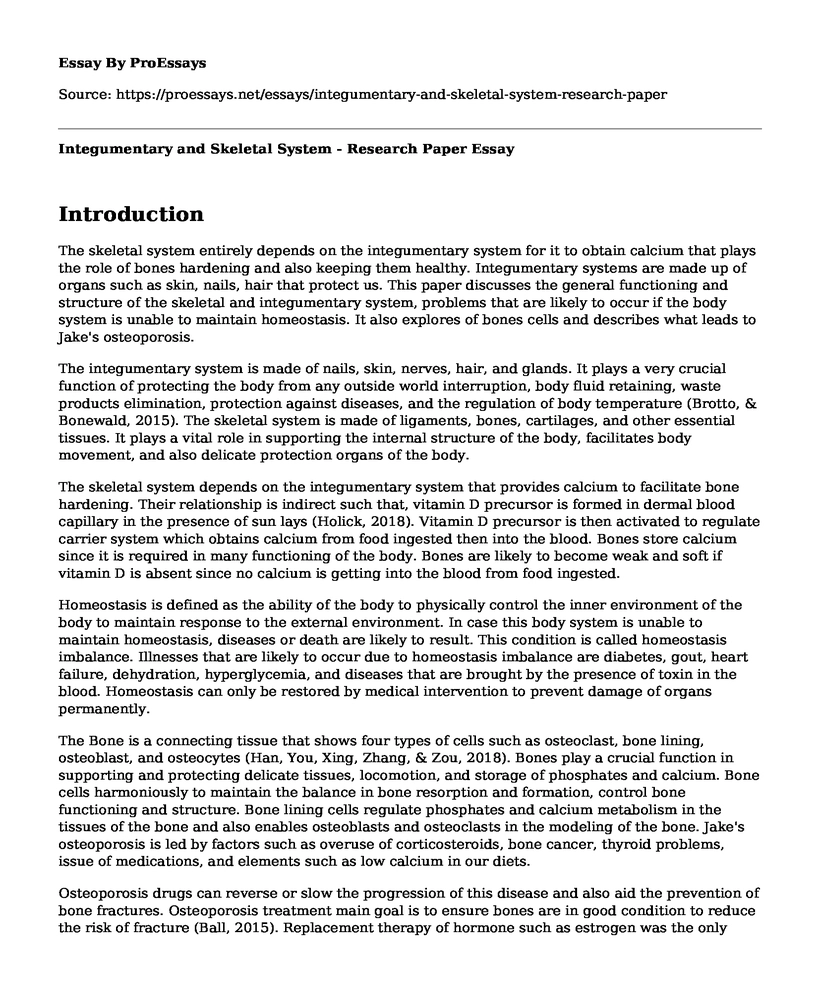Introduction
The skeletal system entirely depends on the integumentary system for it to obtain calcium that plays the role of bones hardening and also keeping them healthy. Integumentary systems are made up of organs such as skin, nails, hair that protect us. This paper discusses the general functioning and structure of the skeletal and integumentary system, problems that are likely to occur if the body system is unable to maintain homeostasis. It also explores of bones cells and describes what leads to Jake's osteoporosis.
The integumentary system is made of nails, skin, nerves, hair, and glands. It plays a very crucial function of protecting the body from any outside world interruption, body fluid retaining, waste products elimination, protection against diseases, and the regulation of body temperature (Brotto, & Bonewald, 2015). The skeletal system is made of ligaments, bones, cartilages, and other essential tissues. It plays a vital role in supporting the internal structure of the body, facilitates body movement, and also delicate protection organs of the body.
The skeletal system depends on the integumentary system that provides calcium to facilitate bone hardening. Their relationship is indirect such that, vitamin D precursor is formed in dermal blood capillary in the presence of sun lays (Holick, 2018). Vitamin D precursor is then activated to regulate carrier system which obtains calcium from food ingested then into the blood. Bones store calcium since it is required in many functioning of the body. Bones are likely to become weak and soft if vitamin D is absent since no calcium is getting into the blood from food ingested.
Homeostasis is defined as the ability of the body to physically control the inner environment of the body to maintain response to the external environment. In case this body system is unable to maintain homeostasis, diseases or death are likely to result. This condition is called homeostasis imbalance. Illnesses that are likely to occur due to homeostasis imbalance are diabetes, gout, heart failure, dehydration, hyperglycemia, and diseases that are brought by the presence of toxin in the blood. Homeostasis can only be restored by medical intervention to prevent damage of organs permanently.
The Bone is a connecting tissue that shows four types of cells such as osteoclast, bone lining, osteoblast, and osteocytes (Han, You, Xing, Zhang, & Zou, 2018). Bones play a crucial function in supporting and protecting delicate tissues, locomotion, and storage of phosphates and calcium. Bone cells harmoniously to maintain the balance in bone resorption and formation, control bone functioning and structure. Bone lining cells regulate phosphates and calcium metabolism in the tissues of the bone and also enables osteoblasts and osteoclasts in the modeling of the bone. Jake's osteoporosis is led by factors such as overuse of corticosteroids, bone cancer, thyroid problems, issue of medications, and elements such as low calcium in our diets.
Osteoporosis drugs can reverse or slow the progression of this disease and also aid the prevention of bone fractures. Osteoporosis treatment main goal is to ensure bones are in good condition to reduce the risk of fracture (Ball, 2015). Replacement therapy of hormone such as estrogen was the only preventive treatment osteoporosis, but nowadays there are other drugs for osteoporosis. Hormone replacement is the best treatment to conserve bone masses and osteoporosis fracture prevention on post-menopause women. It is a functional cure when used to patients who do not have uterine or breast cancer or liver disease.
Conclusion
Based on the above discussion, we have found that the skeletal system depends on the integumentary system for it to obtain calcium that plays the role of bones hardening. The paper concludes by stating that hormone replacement therapy can also be a solution to osteoporosis.
References
Ball, D. (2014). Metabolic and endocrine response to exercise: Sympathoadrenal integration with skeletal muscle. Journal of Endocrinology, 224(2), R79-R95. doi:10.1530/joe-14-0408
Brotto, M., & Bonewald, L. (2015). Bone and muscle: Interactions beyond mechanical. Bone, 80, 109-114. doi:10.1016/j.bone.2015.02.010
Han, Y., You, X., Xing, W., Zhang, Z., & Zou, W. (2018). Paracrine and endocrine actions of bone-the functions of secretory proteins from osteoblasts, osteocytes, and osteoclasts. Bone Research, 6(1). doi:10.1038/s41413-018-0019-6
Holick, M. F. (2018). Photobiology of Vitamin D. Vitamin D, 45-55. doi:10.1016/b978-0-12-809965-0.00004-5
Cite this page
Integumentary and Skeletal System - Research Paper. (2022, Dec 05). Retrieved from https://proessays.net/essays/integumentary-and-skeletal-system-research-paper
If you are the original author of this essay and no longer wish to have it published on the ProEssays website, please click below to request its removal:
- Research Paper on Ecology: Deforestation, Its History and How It Affects Our Ecosystem
- Essay Sample on Classifying Birds: Habits, Habitats & Adaptations
- Essay Sample on Overfishing: A Threat to Marine Ecosystems
- Research Paper on Trends and Dynamics of Bird Species Extinctions in Amazon Rainforest Fragments 1979-2001
- Exploring the Grand Canyon: Nature's Deepest Gorge - Essay Sample
- Essay Sample on Why Is Water Not Free?: Understanding the Need to Manage Natural Resources
- Nancy Turner: Ethnobotanical Uses and Significance of Wild Rose Plants - Essay Sample







